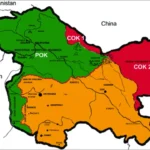May 22, 2025 — In a groundbreaking discovery, scientists at NASA have revealed that trees can serve as early indicators of volcanic activity, detectable via satellite from space. This innovative method leverages satellite data to monitor subtle changes in forest health, offering a new and natural tool for predicting volcanic eruptions before they occur.
The research, recently published in a leading geophysical journal, demonstrates that trees growing near volcanoes can absorb increased levels of carbon dioxide (CO₂) released from underground magma activity. These emissions, often invisible to traditional monitoring systems, cause physiological stress in trees—changes that can be identified through NASA’s Earth-observing satellites.
🌲 Trees as Natural Volcanic Sensors
At the center of this breakthrough is NASA’s use of remote sensing technology and data from instruments such as the Landsat and ECOSTRESS missions. Scientists analyzed satellite imagery over time, focusing on infrared and thermal data to track photosynthetic activity in vegetation surrounding active volcanoes.
“We’ve essentially discovered a way to listen to volcanoes by observing how nearby forests react to gas leaks underground,” said Dr. Diego Morales, a NASA Earth scientist and lead author of the study. “This is a new kind of early warning system—one that relies on nature’s own sensitivity.”
🌋 Case Study: Mount Taranaki in New Zealand
The method was tested on several volcanoes worldwide, with a particularly successful trial conducted at Mount Taranaki in New Zealand. Satellite data showed noticeable drops in vegetation health in the months leading up to minor volcanic tremors, all linked to underground CO₂ release.
This early vegetation stress signal appeared before any seismic activity, providing a potential lead time of several weeks—a game-changer for volcano monitoring systems that currently rely heavily on seismic and ground deformation data.
🛰️ The Contribution of AI and Satellite-Based Earth Observation
The detection technique uses AI-powered algorithms to assess changes in chlorophyll levels and heat patterns. When trees absorb elevated CO₂ levels, their photosynthesis slows down—a shift that can be picked up as a decline in plant health using thermal imaging from space.
NASA’s ECOSTRESS (ECOsystem Spaceborne Thermal Radiometer Experiment on Space Station) was instrumental in the research. It captures heat signatures in plants, helping scientists interpret how environmental stress factors, like volcanic gas exposure, impact plant function.
🌐 A Global Application for Volcanic Risk Management
This approach could have major implications for volcano-prone regions, especially in countries where building traditional seismic networks is logistically or economically challenging. By monitoring forests around volcanoes, authorities may gain a low-cost, scalable tool to enhance disaster preparedness and reduce human risk.
“Forests might be our first line of defense against volcanic disasters,” noted Dr. Morales. “By expanding satellite monitoring to more active volcanoes globally, we can offer earlier alerts and potentially save lives.”
🔍 What’s Next for NASA’s Research
NASA plans to extend the study to other volcanoes across the Pacific Ring of Fire, as well as dormant ones showing signs of renewed activity. Future collaborations with environmental agencies and geological institutes are expected to integrate this method into existing volcano monitoring frameworks.
Additionally, the research team is exploring how this technology could help identify underground gas leaks, geothermal activity, and even environmental pollution, broadening its application well beyond volcanology.





